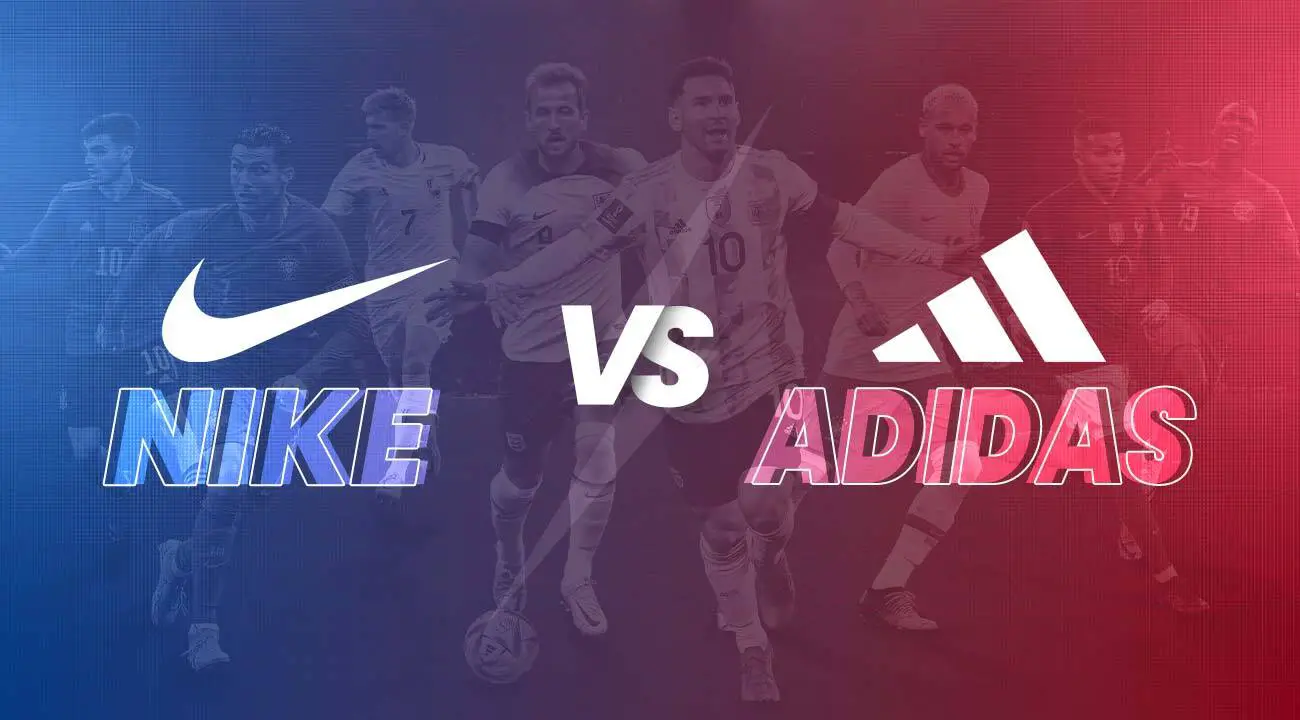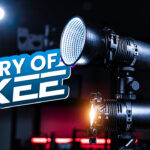Table of Contents
When it comes to sports, Nike and Adidas are two brands that come to mind immediately. Both companies are associated with various sports and physical activities such as football, baseball, basketball, hockey, tennis, golf, cycling, swimming, and yoga. For the past four decades, Nike has been the market leader in the world’s sportswear market while Adidas is the market challenger.
Although they both use similar strategies in terms of advertising, celebrity endorsement, influencer marketing, innovation, and diversification, each brand has its own unique approach. This has led to a brand war between the two companies for market domination.
For example, Adidas was the jersey sponsor for the 2022 FIFA Men’s World Cup champion Argentina, while Nike was the sponsor for the World Cup runner-up France. Lionel Messi represents Adidas while Cristiano Ronaldo represents Nike. In addition to football, the two brands compete in major tournaments like basketball, American football, baseball, tennis, golf, and the Olympics.
According to a 2020 article by Datahut, Adidas has over 2600 product categories in its portfolio, while Nike has only 643. Despite this vast difference, Nike leads the global sportswear market due to its unique business model and marketing strategies.
Nike vs. Adidas: An Overview
Adidas
The fall of the Dassler Brothers shoe factory resulted in the creation of two leading footwear companies, Adidas and Puma. Adidas was established in 1949 by Adolf Dassler and initially only sold footwear products. Over time, the company expanded its product offerings by adding new lines, now offering a diverse range of sportswear and accessories, in addition to footwear.
Nike
Phill Knight and Bill Bowerman founded Blue Ribbon Sports in 1964, which was later renamed “Nike Inc.” in 1971. Similar to Adidas, Nike started as a footwear company and later expanded into the clothing, accessories, and equipment industry.
As per Statista, Nike’s current brand value is estimated to be over $42 billion, while Adidas’s brand value is only estimated to be at $13 billion. Furthermore, Nike’s market valuation is estimated to be over $170 billion, while Adidas’ market valuation is only valued at $22 billion, making Nike’s market valuation approximately 8 times that of Adidas. Additionally, Nike has proven to be ahead of Adidas in terms of sales revenue and customer preferences for both male and female customers. In the year 2021, Nike’s revenue was reported to be more than $46 billion, almost double that of Adidas’s revenue which was estimated at $26 billion.

Nike vs. Adidas: Battle Of The Sports Goliaths
Fifa World Cup Kit Battle
At every FIFA World Cup, continuing competition ensues between various global brands with regard to the kit sponsorship of national teams. The two primary players in this competition are Nike and Adidas. Out of the 32 teams participating in the 2022 FIFA World Cup, 13 teams have their kits sponsored by Nike, while 7 teams have their kits sponsored by Adidas.
In terms of sponsorship, both companies endeavor to align themselves with teams that are expected to perform well in the World Cup, as the success of these teams can impact their sales. For instance, following Germany’s elimination in the group stage of the 2018 World Cup, the stock price of their sponsor, Adidas, fell by 6 percent during the World Cup. Conversely, when France won the World Cup, the stock price of its sponsor, Nike, rose by 4 percent.
This brand rivalry between Adidas and Nike was also evident in the final of the 2022 FIFA World Cup, where Argentina, sponsored by Adidas, faced France, sponsored by Nike. Although Adidas appears to have come out on top after Argentina’s World Cup victory, Nike also had a hand in this success. That is because FIFA awards five prizes at the end of each World Cup, including the Golden Ball, Golden Gloves and Golden Boot, which are sponsored by Adidas.
The recipient of the Adidas Golden Boot in the 2022 World Cup was France’s Kylian Mbappé, with whom Nike has a partnership agreement. In other words, every time Adidas is associated with the Golden Boot, both Kylian Mbappé and Nike receive exposure.
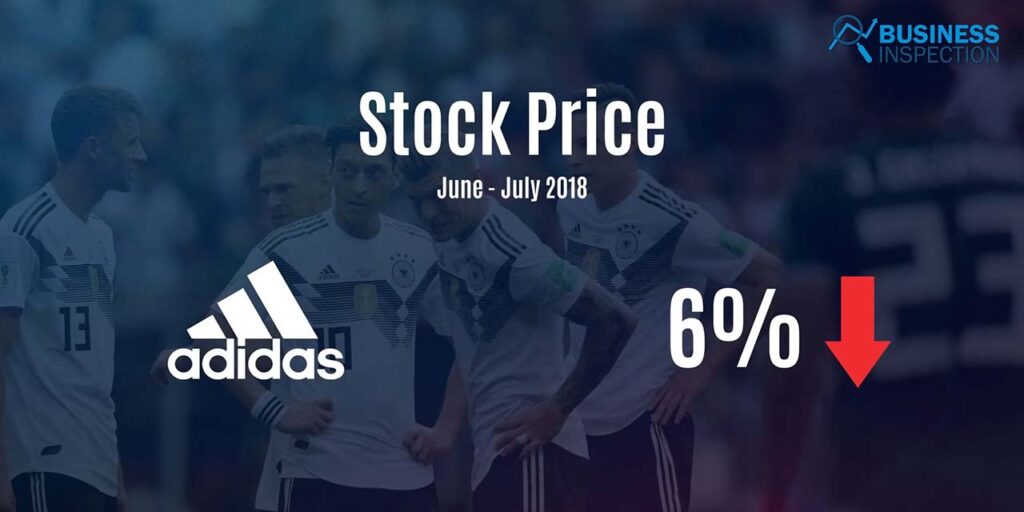
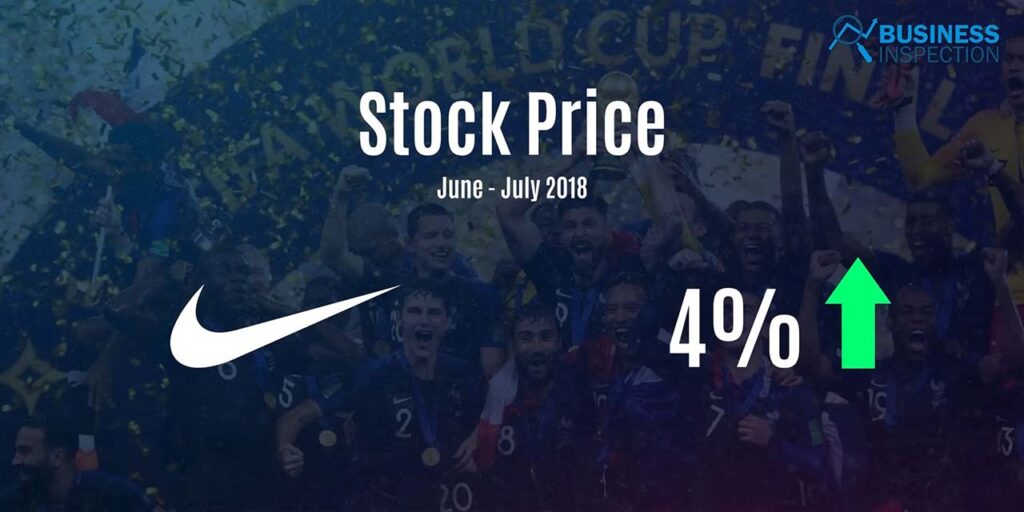
Messi VS Ronaldo
Messi and Ronaldo have been the most talked about names in the world of football for more than a decade. Although Messi is currently endorsed by Adidas and Cristiano Ronaldo by Nike, at one time both footballers wear under Nike’s umbrella.
Messi has been using Nike shoes and other accessories since the age of 14, and despite Nike being Barcelona’s kit sponsor, he signed a contract with Adidas in 2006, which became a lifetime contract in 2017. Ronaldo, on the other hand, signed a contract with Nike in 2003 which later resulted in a partnership with Nike to launch CR7’s own brand and a lifetime contract in 2017.
According to the book ‘Ronaldo: One Rivalry, Two GOATs, and the Era That Remade the World’s Game’, Messi’s father, Jorge, felt that Messi was not receiving proper appreciation from Nike because Nike ignored Messi’s request to send him some additional athletic gear. As a result, Adidas entered into a bidding war with Nike and in 2006, just before the World Cup, the company signed Messi to a 5-year contract for what was then £400,000 per year.
Besides, to keep Messi happy in this contract, the company has also released special edition boots for Messi every year in addition to ensuring the highest priority for him. Even in the 2022 World Cup, Messi launched the Adidas X Speedportal Leyenda, an exclusive boot whose design inspiration was taken from the design of Messi’s first World Cup boot in 2006.

Argentina VS Brazil
The rivalry between Argentina and Brazil is considered one of the greatest among football enthusiasts in Bangladesh. The worldwide popularity of football in these two countries has generated a substantial business opportunity for team sponsors.
As a result, Adidas has been sponsoring the Argentina team since the 1974 World Cup, and Nike has held the position as the official jersey sponsor for Brazil since 1996, with their contract extended until 2026. Meanwhile, Adidas’ agreement with Argentina is set to conclude in 2022, however, it is anticipated that based on Argentina’s performance in the 2022 World Cup, Adidas may seek to extend the contract for few more additional years.
Barcelona VS Real Madrid
The rivalry between the Spanish football clubs, Real Madrid and Barcelona, known as El Clasico, transcends the boundaries of Europe and has a global audience of over 700 million people. Equally intense is the competition between the sportswear companies, Nike and Adidas. Since 1998, these two companies have been the official jersey sponsors for the two Spanish clubs, with Adidas sponsoring Real Madrid and Nike sponsoring Barcelona. This sponsorship is driven by the massive worldwide following and impressive net worth of both clubs.
Real Madrid holds the first position with a net worth of $5.1 billion and approximately 275 million social media followers, while Barcelona takes second place with a net worth of $5 billion and around 260 million social media followers. The sponsorship agreements between both clubs and sportswear companies are set to continue until 2028.

Rivalry In Tennis
Upon examination of the tennis rankings, it becomes evident that the trend of sportswear sponsorship continues to hold true here as well. Carlos Alcarez and Rafael Nadal occupy the first and second positions in the men’s tennis rankings of 2022, with both being endorsed by Nike.
Similarly, Stefanos Tsitsipas and Felix Auger-Aliassime occupy the fourth and sixth positions, with their respective kit sponsors being Adidas. In the women’s tennis rankings, Caroline Garcia holds the fourth position and is sponsored by Adidas, while Aryna Sabalenka, who is ranked fifth, is sponsored by Nike.
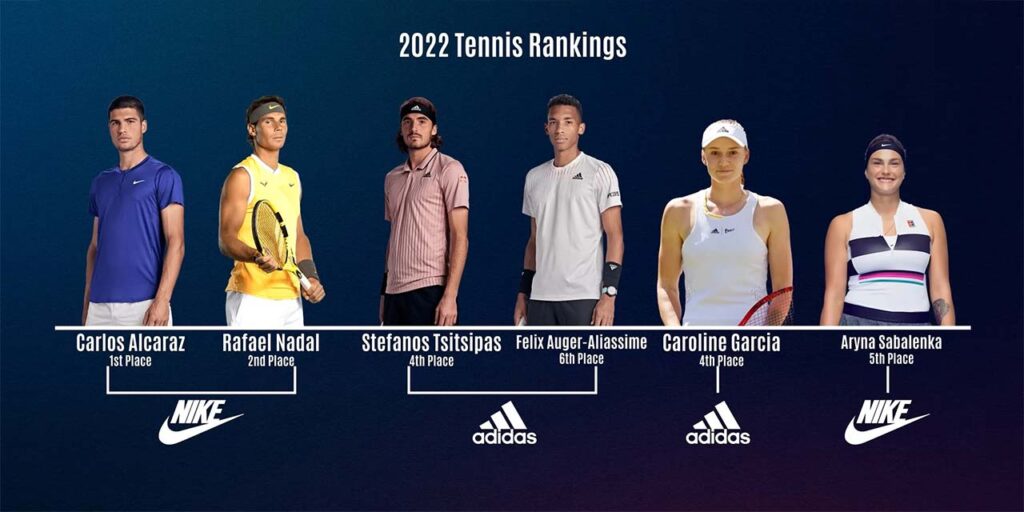
Olympic Rivalry
Adidas and Nike both sought to secure the title sponsorship for the 2012 London Olympics. However, Adidas emerged victorious, having secured the contract at a cost of $150 million. Subsequently, the company collaborated with the Olympic Committee to establish strict rules and regulations, including the prohibition of any other company from associating with the Olympic Games and from utilizing Olympic athletes in commercials.
Despite these restrictions, the Nike marketing team was undeterred and found a loophole in the terms and conditions by sponsoring the shoes of 400 participating athletes. As the company was forbidden from using the city of London, it instead utilized 29 other locations named London in its advertisements.
In response to the ban on commercials featuring Olympic athletes, Nike created the #FindYourGreatness campaign, which highlighted the Olympian spirit in everyday people without featuring actual Olympians. Meanwhile, Adidas, as the official sponsor, launched the #TaketheStage commercial featuring the athletes.
Despite the advantage of being an official sponsor, Nike’s #FindYourGreatness campaign received 4.5 million views on YouTube, 1.3 million more than #TaketheStage, and dominated in terms of tweets, follower additions, and survey results. Nike’s marketing efforts ultimately turned Adidas’ $150 million investment into a failed project.

NBA Athletic Apparel War
In 2006, Adidas acquired Reebok and, as a result, became the official uniform and apparel sponsor of the National Basketball Association (NBA) through a contract worth $400 million over 11 years. However, in March 2015, Adidas announced that it would not extend its partnership with the NBA beyond the 2016-2017 season.
This opportunity was seized by Nike, who signed an 8-year contract with the NBA, the value of which remains undisclosed, though it is estimated to cost the company approximately $1 billion annually. This represents a 245% increase from Adidas’ previous deal with the NBA.
The rivalry between Nike and Adidas in the NBA dates back to 1984 when Nike was less well-known in the footwear market compared to Adidas and Converse. In order to increase visibility, Nike sought a basketball icon to promote the brand, but at the time, nearly all the prominent NBA players were partnered with Adidas or Converse.
This forced Nike to approach the rookie basketball player Michael Jordan, who was initially approached and rejected by Adidas due to his lack of experience. After several attempts, Nike was able to convince Jordan to partner with them by tailoring their product to his specific requirements. This led to the launch of the Air Jordan brand, which is now worth around $10 billion and is one of the reasons why Nike has surpassed Adidas in the competition.
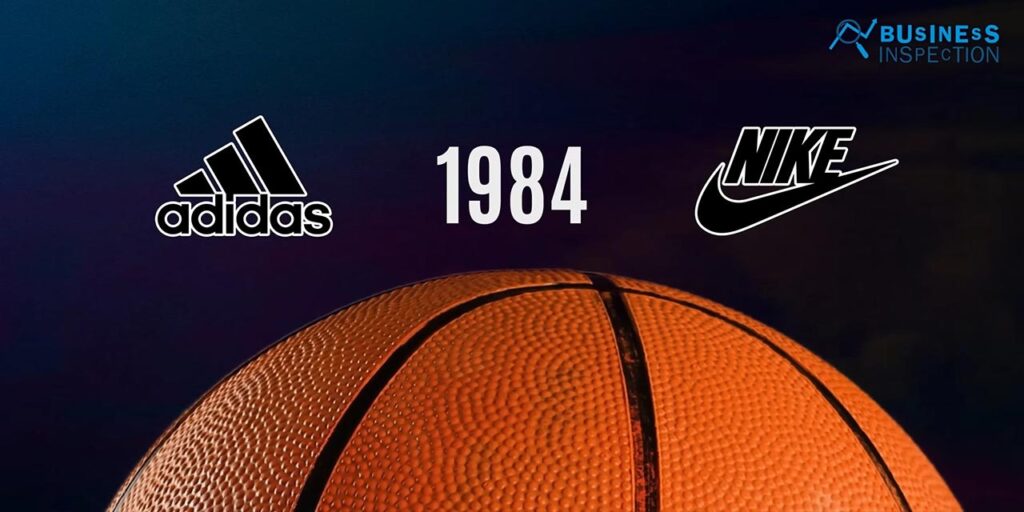
Design Battle
Nike and Adidas consistently surpass their competitors in the market due to their exceptional product design. Both firms collaborate with renowned celebrities and designers, as well as continually upgrading their product offerings. For instance, when the first Air Jordan was launched in 1984, Nike incorporated Michael Jordan’s input into the design process.
However, when Kanye West publicly criticized Nike for a lack of creative freedom in 2014, Adidas seized the opportunity. That same year, Adidas launched the Yeezy Boost 750 in partnership with Kanye West, which was sold out in moments. Furthermore, three top Nike designers – Denis Dekovic, Marc Dolce, and Mark Miner – eventually migrated to Adidas. The company sought to demonstrate to consumers that it places a high value on designers’ creative autonomy and design innovation and that customers would receive superior design products as a result.
Innovation War
In the year 2017, Adidas introduced a 3D-printed sole which provided customers with greater opportunities for customization. Conversely, in 2019, Nike acquired a Boston-based predictive analytics firm, Celect, with the aim of monitoring customer demand and behavior in real-time. This has enabled the company to offer a more personalized experience and ensure the delivery of superior products to customers. In 2021, Nike made a significant leap into the Metaverse by establishing “Nikeland” in the gaming platform, Roblox, and incorporating augmented reality lenses on Snapchat.
Moreover, in December 2021, Nike acquired RTFKT for approximately $1 billion to enhance its early-mover advantage and dominance in the NFT market. Following in Nike’s footsteps, Adidas also entered the virtual space by creating a decentralized playground in the Blockchain-based gaming world, The Sandbox, and collaborating with the Bored Ape Yacht Club (BAYC) NFT. According to Associate Professor of Maryville University and former Nike consultant, Dustin York, both Nike and Adidas are moving towards Web 3.0 and Metaverse, however, their strategies differ significantly from one another.
Tactical war
It can be observed that there is a noteworthy disparity between the marketing budget allocation of Nike and Adidas. Nike allocates a substantial portion of their budget toward advertising, whereas Adidas invests in sponsorship. For instance, when Adidas sponsored both Argentina and Germany in the 2014 finals, it was believed that Adidas would have a better chance of success.
However, Nike’s unconventional marketing approach and innovative advertisements surprised many. They released a 5-minute animated commercial entitled “The Last Game” which focused on the final match and became one of the most widely shared posts on Facebook and one of the most popular videos on YouTube. Additionally, although Germany’s jerseys were sponsored by Adidas, Mario Gotze, the player who scored the winning goal for Germany in the World Cup, had his boots sponsored by Nike, giving the company an edge.
As The Dust Settles…
The ongoing sneaker war between Nike and Adidas has persisted for several years, akin to the cola and pizza wars. Despite this intense competition, both companies have reaped significant benefits, as the continuous efforts to improve and innovate have enabled them to stay ahead of other competitors such as Puma, Under Armour, and Fila.


